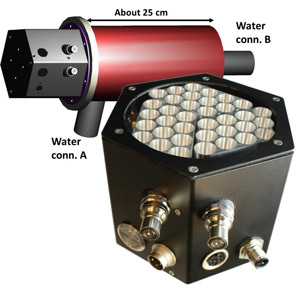- News
7 December 2018
OSA develops 4W UVC LED water disinfection module
OSA Opto Light GmbH of Berlin, Germany (which makes custom-designed LED chips, SMD LEDs and LED modules emitting at wavelengths ranging from UV 350-420nm to VIS 420-660nm and IR 660-1080nm) has developed a high-performance UVC LED radiation source, emitting 4W optical power at an emission wavelength 275-280nm.
 Figure 1. OSA’s UVC LED module for water disinfection.
Figure 1. OSA’s UVC LED module for water disinfection.
The firm collaborated with CiS Forschungsinstitut für Mikrosensorik GmbH, the Advanced System Technology branch of the Fraunhofer-Institute für Optronik, Systemtechnik und Bildauswertung (IOSB, Fraunhofer Institute of , System Technologies and Image Exploitation), and Xylem Services GmbH, as part of the water disinfection activities within the ‘Advanced UV for Life’ consortium of more than 47 German industrial and academic partners, which work together on the development and application of UV LEDs within the framework of the ‘Zwanzig20’ initiative funded by the German Federal Ministry of Education and Research (BMBF).
Several key features were implemented in the new LED module:
- a unique aluminium parabolic array of reflectors emitting light at an angle of about 15°;
- new anti-reflection coating on the front window with a transmission value of about 97% for wavelengths of 270-280nm;
- reliable and efficient chip-mounting process;
- a new heat sink with a 40% lower thermal resistance compared with the old design, allowing low operation temperatures at power losses up to 400W;
- integrated electronic control unit with computer software enabling good monitoring of the operation state of the system, overheating protection, and a safety shutdown; and
- computer-independent operation mode with the last saved settings.

Figure 2. Irradiance distribution of the 4W LED module.
Figure 2 shows the distribution of irradiance at distances of 1, 10 and 30cm from the front window. The parabolic reflector arrays yields a maximum optical power density at a distance of 25cm of about 30mW/cm2 (50% of the initial maximum optical power density). For comparison, the blue curve in Figure 2 shows the Lambertian radiation of an LED module without a lens or parabolic reflectors.


